ASTM 铜片腐蚀测定法
汽柴油铜片腐蚀快速试验法

PetroChina Lanzhou Lubricant R&D Institute
汽油、柴油铜片腐蚀试验法 快速法
6 试验步骤
6.1
把完全清澈、无悬浮水的试样倒入清洁、干燥的试管中30 mL刻
线处,并将经过最后磨光、干净的铜片在1min内浸入该试管的试样中。 将该试管小心地滑入试验钢弹中,并把弹盖旋紧,然后将试验钢弹完 全浸入已维持在90℃±1℃的恒温浴中恒温。 6.2 恒温30min后,小心地取出试验钢弹,并用自来水冲洗试验钢弹
测定。
中 国 石 油 兰 州 润 滑 油 研 发 中 心
PetroChina Lanzhou Lubricant R&D Institute
汽油、柴油铜片腐蚀试验法 快速法
日常操作注意事项
打磨合格的铜片对试验结果至关重要 磨光后的铜片禁止用手接触 浴温要保持在90℃±1℃范围内 所用试剂应经铜片试验合格后使用 试管小心滑入试验弹后,必须旋紧弹盖 从恒温浴中取出的试验弹用自来水冷却到 室温并擦干后再打开
ASTM D4814 汽油 ASTM D975 柴油 EN 228 汽油 EN 590 柴油 JIS K2202 汽油 JIS K2204 柴油 汽油 柴油 GB 1793 车用汽油 GB 252 轻柴油 GB 19147 车用柴油
中 国 石 油 兰 州 润 滑 油 研 发 中 心
PetroChina Lanzhou Lubricant R&D Institute
汽油、柴油铜片腐蚀 快速试验法介绍
兰州润滑油研究开发中心 2011年5月
石油产品的腐蚀性 石油产品的腐蚀性
金属接触
ASTM D130-12译文

ASTM D 130-12译文石油产品铜片腐蚀标准试验方法1 范围1.1本方法适用于测定航空汽油、喷气燃料、车用汽油、清洗溶剂油、煤油、柴油、馏分燃料油、润滑油、天然汽油或其他具有37.8℃雷德蒸气压不大于124干帕斯卡(18磅/平方英尺)的其他石油烃类产品对铜的腐蚀。
警告:某些石油产品,特别是天然汽油,其蒸气压比车用汽油或航空汽油的蒸气压更高。
因此,必须特别注意,一定不要把装有高蒸气压的天然汽油或其他产品的试验弹放在100℃浴中。
雷德蒸气压超过124干帕斯卡(18磅/平方英寸)的试样要采用D 1838试验法来测定1.2 本标准采用国际单位制SI单位。
括号内的数据仅为提供信息之用。
1.3本标准涉及某些有危险性的材料、操作和设备,但是无意对与此有关的所有安全问题都提出建议。
因此,用户在使用本标准之前应建立适当的安全和防护措施并确定有适用性的管理制度。
特别注意事项见1.1、6.1和附录A2。
2 参考文件2.1 ASTM标准ASTM D 396燃料油规格ASTM D 975柴油规格ASTM D 1655 航空喷气燃料规格ASTM D 1838 液化石油气铜片腐蚀测定法ASTM D 4057石油和石油产品的手工取样用标准实施规程ASTM D 4177石油和石油产品自动抽样的标准实施规程ASTM D 6300石油产品和润滑剂试验方法中使用的精确度和偏差数据测定的标准实施规程ASTM E 1 ASTM玻璃液体热力计规格2.2 ASTM标准附件ASTM铜片腐蚀标准色板3 术语3.1首字母缩略词3.1.1 CAMI:表明覆盖磨料制造者协会3.1.2 FEPA:欧共体生产者协会4方法概要4.1把一块已抛光好的铜片浸没在一定里的试样中,并按产品标准要求加热到指定的温度,保持一定的时间。
待试验周期结束时,取出铜片,经洗涤后与腐蚀标准色板进行比较,确定腐蚀级别。
5 意义和用途5.1原油中的大部分硫化物在精制的过程中被除去,但是,残留在油品中的某些硫化物会对各种金属产生腐蚀。
铜片腐蚀测定器的腐蚀级别评定

铜片腐蚀测定器的腐蚀级别评定简介铜片腐蚀测定器,是用来评定特定研究对象在特定条件下发生的腐蚀过程,以此来判断材料的耐腐蚀性能。
铜片腐蚀测定器适用于研究不锈钢、镍基合金等材料在不同环境、不同温度、不同介质、不同氧化还原电位等多种条件下的耐腐蚀性能。
铜片腐蚀测定器的评定结果能够在很大程度上反映出材料或产品在实际使用中的适用性和持久性,因此对于材料或产品的研发和应用具有重要意义。
原理铜片腐蚀测定器的原理是将铜片置于被评测的环境中,通过定期对铜片进行观测,根据铜片腐蚀的情况来评定环境的腐蚀性质以及研究材料耐腐蚀性能。
通过铜片腐蚀的级别评定,我们可以获得被评测材料的耐腐蚀性能并将其分为以下五个等级:1级、2级、3级、4级和5级。
其中1级最能耐腐蚀,5级最不耐蚀。
评定过程铜片腐蚀测定器的评定过程通常需要进行以下步骤:1.制备铜片:使用洗涤剂和紫外线灯芯对铜板表面进行清洗和处理,在紫外线灯下自然晾晒或用纸巾擦净表面氧化物。
2.将处理后的铜片放入测定器中,加入被测液体或气体,根据具体情况确定试验条件,例如:温度、浓度、震荡等。
3.每天或每隔一段时间,观察铜片表面的颜色和状态,记录下来。
4.根据参考图例对铜片的腐蚀程度进行评估,并确定质量等级。
评定标准评定标准通常采用铜平均重量损失测量法,分为五个等级:•一级:铜片平均重量损失小于5mg/dm2•二级:铜片平均重量损失5-10mg/dm2•三级:铜片平均重量损失10-30mg/dm2•四级:铜片平均重量损失30-50mg/dm2•五级:铜片平均重量损失大于50mg/dm2结论通过铜片腐蚀测定器对被评测材料进行腐蚀级别评定,可以评估该材料在特定条件下的耐腐蚀性能,并确定其质量等级。
评定结果具有一定的可靠性和参考价值,可以为材料或产品的研发和应用提供重要依据。
需要注意的是,评定结果仅仅表征了被评测材料在某一条件下的腐蚀性能,因此需要结合实际应用条件进行综合分析和评价。
石油产品铜片腐蚀测定方法步骤
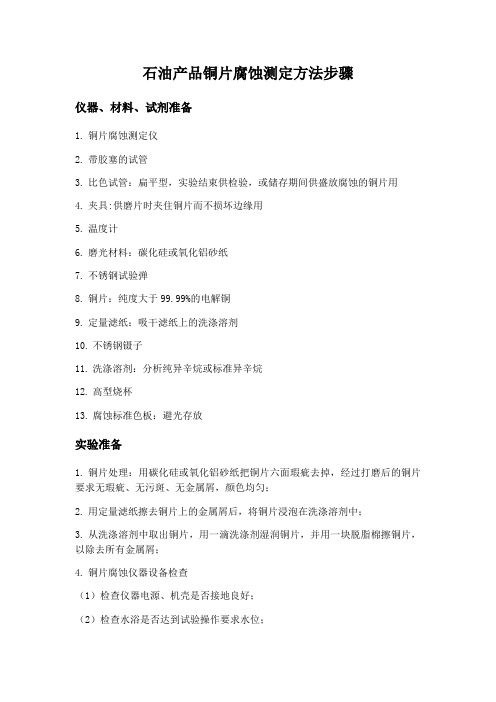
石油产品铜片腐蚀测定方法步骤仪器、材料、试剂准备1.铜片腐蚀测定仪2.带胶塞的试管3.比色试管:扁平型,实验结束供检验,或储存期间供盛放腐蚀的铜片用4.夹具:供磨片时夹住铜片而不损坏边缘用5.温度计6.磨光材料:碳化硅或氧化铝砂纸7.不锈钢试验弹8.铜片:纯度大于99.99%的电解铜9.定量滤纸:吸干滤纸上的洗涤溶剂10.不锈钢镊子11.洗涤溶剂:分析纯异辛烷或标准异辛烷12.高型烧杯13.腐蚀标准色板:避光存放实验准备1.铜片处理:用碳化硅或氧化铝砂纸把铜片六面瑕疵去掉,经过打磨后的铜片要求无瑕疵、无污斑、无金属屑,颜色均匀;2.用定量滤纸擦去铜片上的金属屑后,将铜片浸泡在洗涤溶剂中;3.从洗涤溶剂中取出铜片,用一滴洗涤剂湿润铜片,并用一块脱脂棉擦铜片,以除去所有金属屑;4.铜片腐蚀仪器设备检查(1)检查仪器电源、机壳是否接地良好;(2)检查水浴是否达到试验操作要求水位;(3)检查浴内温度传感器是否正常;实验步骤1.将试验仪器放置平稳,接通电源,使水浴温度维持在50O C±1O C;2.把被测油样倒入清洁、干燥的试管中;3.将经过最后磨光、干净的铜片在1分钟内浸入该试管的试样中;4.把该试管放到温度维持在50O C±1O C的水浴中,记录实验开始时间;5.在水浴中放置3小时±5分钟后,从仪器中取出装有铜片的试管;6.用不锈钢镊子立即将铜片从试管中取出,浸入放有洗涤溶剂的高烧杯中,洗去试样;7.立即取出铜片,用定量滤纸吸干铜片上的洗涤溶剂;8.把铜片与腐蚀标准色板比较,来检查变色或腐蚀迹象,比较时,可将铜片放在扁平试管中,将铜片和腐蚀标准色板对光线成45O角折射的方式拿持,进行观察实验结果。
铜片腐蚀 标准

铜片腐蚀标准
铜片腐蚀测试是用于评估工业润滑油或其他石油产品对铜的腐蚀性能的试验。
测试的执行标准主要有两种:ASTM D130-16和GB/T 5096。
在ASTM D130-16标准中,腐蚀等级通常分为1级、2级、3级和4级,
而根据GB/T 5096标准,腐蚀等级则分为1a、1b、2a、2b、2c等。
测试方法是将一块已磨光好的铜片浸没在一定量的试样中,并按产品标准要求加热到指定的温度,保持一定的时间。
在试验过程中,铜片表面受待测式样的侵蚀程度反映了石油产品的腐蚀性。
根据GB/T 5096标准,腐蚀程度分为四级,从轻微腐蚀到严重腐蚀,每级
对应的颜色变化不同。
完全无腐蚀的铜片为A级(与ASTM的1级、GB/T 5096的1a和1b级别相对应),轻微腐蚀的铜片为B级(与ASTM的2
级和GB/T 5096的2a和2b级别相对应),中度腐蚀的铜片为C级(与ASTM的3级和GB/T 5096的2c级别相对应),严重腐蚀的铜片为D级(与ASTM的4级相对应)。
以上信息仅供参考,如需获取更多详细信息,建议查阅相关标准或咨询专业人士。
铜片腐蚀试验操作规程[终稿]
![铜片腐蚀试验操作规程[终稿]](https://img.taocdn.com/s3/m/25a2334a3a3567ec102de2bd960590c69ec3d8ae.png)
铜片腐蚀试验操作规程
试验前的准备:
1、试片的制备:
先用碳化硅或氧化铝(刚玉)砂纸(或纱布)把铜片六个面上的瑕疵去掉。
再用65微米(240粒度)的碳化硅或氧化铝(刚玉)砂纸(或纱布)处理,以除去在此以前用其他等级砂纸留下的打磨痕迹。
打磨时,把一张砂纸放在平坦的表面上,用煤油或洗涤溶剂湿润砂纸,以旋转的动作将铜片对着砂纸摩擦,用无灰滤纸或夹钳夹持。
以防止铜片与手指接触。
打磨完用定量滤纸擦区铜片上的金属屑,把铜片浸没在洗涤溶剂中备用。
2、取样:
容器要尽可能装满试样,取样后立即盖上,取样时要小心,防止试样暴露于直接的阳光下,甚至散射的日光下。
实验室收到试样后,在打开容器后尽快进行实验。
试验步骤:
1、把完全清澈和无任何悬浮水或无内含水的试样倒入清洁、干燥的试管
中30毫升刻线处,并将经过最后磨光的干净的铜片在1分钟内浸入该试管的试样中。
用一个有排气孔的软木塞塞住试管。
把该试管放到50±1℃的水浴中。
在浴中放置3小时±5分钟后,按下步检查铜片。
2、试管的内容物倒入150毫升高型烧杯中,倒时要让铜片轻轻地滑入,
以免碰破烧杯。
用不锈钢镊子立即将铜片取出,浸入洗涤溶剂中,洗
去试样。
立即取出铜片,用定量滤纸吸干铜片上的洗涤溶剂。
把铜片放入扁平试管中,用棉花塞住管口,把铜片与腐蚀标准色板比较来检查变色或腐蚀迹象。
比较时,铜片和腐蚀标准色板对光线成45度角的折射方式拿持,进行观察。
腐蚀铜片变色说明。
astm 铜片腐蚀标准比色板
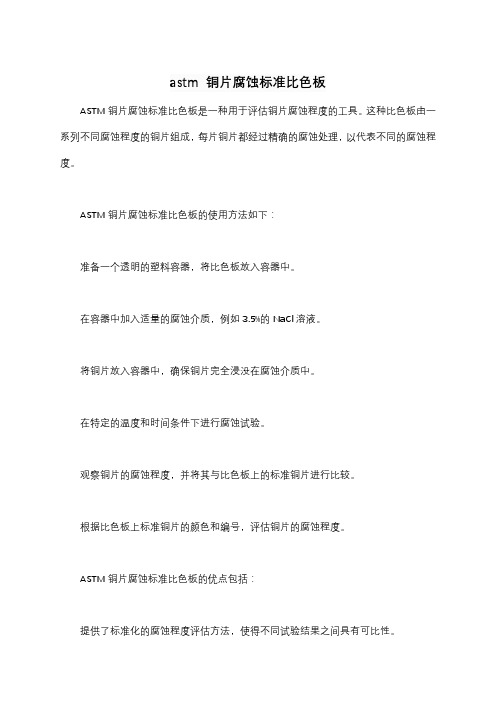
astm 铜片腐蚀标准比色板
ASTM铜片腐蚀标准比色板是一种用于评估铜片腐蚀程度的工具。
这种比色板由一系列不同腐蚀程度的铜片组成,每片铜片都经过精确的腐蚀处理,以代表不同的腐蚀程度。
ASTM铜片腐蚀标准比色板的使用方法如下:
准备一个透明的塑料容器,将比色板放入容器中。
在容器中加入适量的腐蚀介质,例如3.5%的NaCl溶液。
将铜片放入容器中,确保铜片完全浸没在腐蚀介质中。
在特定的温度和时间条件下进行腐蚀试验。
观察铜片的腐蚀程度,并将其与比色板上的标准铜片进行比较。
根据比色板上标准铜片的颜色和编号,评估铜片的腐蚀程度。
ASTM铜片腐蚀标准比色板的优点包括:
提供了标准化的腐蚀程度评估方法,使得不同试验结果之间具有可比性。
提供了直观的腐蚀程度表示方法,方便观察和记录。
适用于多种腐蚀介质和试验条件,具有广泛的应用范围。
需要注意的是,ASTM铜片腐蚀标准比色板的使用需要专业的知识和技能,并且需要按照ASTM标准进行操作。
在使用过程中,需要注意安全和卫生问题,避免接触腐蚀介质和高温设备。
7 铜片腐蚀测定仪操作规程

铜片腐蚀测定仪
操作规程
1、测试前的准备
1.1仔细阅读中华人民共和国标准GB/T5096-2017《石油产品铜片腐蚀试验法》,了解并熟悉标准所阐述的试验方法、试验步骤和试验要求。
1.2按标准所规定的要求,准备好试验用的各种试验器具、材料等。
1.3检查仪器的作状态,应符合说明书所规定的工作环境和工作条件。
2、仪器操作说明
2.1 将仪器放在水平位置上。
2.2接通电,打开电源开关及搅拌开关,此时主加热器开始工作,仪器处于升温加热状态。
2.3根据试验的要求,可通过温控仪上的温度设定按钮和调节电位器来选择所需要的控温温度。
2.4打开辅助加热开关,加快升温速度。
当显示温度低于设定温度的3~5℃时,即关闭辅助加热开关。
2.5当温度到达该点时,控温仪便自动控制温度。
稳定后,仪器即可投入试验。
2.6温度恒定以后,请按GB/T5096的规定进行试验。
2.7按产品试验方法,试验结束后,应关闭电源。
2.8、仪器应经常做清洁工作,同时检查温控仪、温度传感器工作是否正常。
2.9、仪器使用完毕后,不再继续使用时,应及时拔掉电源插头。
1、ASTM D849工业芳烃的铜腐蚀试验方法
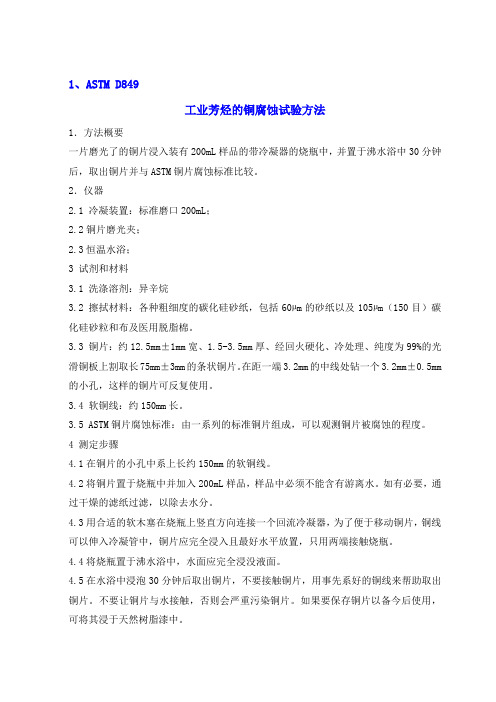
1、ASTM D849工业芳烃的铜腐蚀试验方法1.方法概要一片磨光了的铜片浸入装有200mL样品的带冷凝器的烧瓶中,并置于沸水浴中30分钟后,取出铜片并与ASTM铜片腐蚀标准比较。
2.仪器2.1 冷凝装置:标准磨口200mL;2.2铜片磨光夹;2.3恒温水浴;3 试剂和材料3.1 洗涤溶剂:异辛烷3.2 擦拭材料:各种粗细度的碳化硅砂纸,包括60µm的砂纸以及105µm(150目)碳化硅砂粒和布及医用脱脂棉。
3.3 铜片:约12.5mm±1mm宽、1.5-3.5mm厚、经回火硬化、冷处理、纯度为99%的光滑铜板上割取长75mm±3mm的条状铜片。
在距一端3.2mm的中线处钻一个3.2mm±0.5mm 的小孔,这样的铜片可反复使用。
3.4 软铜线:约150mm长。
3.5 ASTM铜片腐蚀标准:由一系列的标准铜片组成,可以观测铜片被腐蚀的程度。
4 测定步骤4.1在铜片的小孔中系上长约150mm的软铜线。
4.2将铜片置于烧瓶中并加入200mL样品,样品中必须不能含有游离水。
如有必要,通过干燥的滤纸过滤,以除去水分。
4.3用合适的软木塞在烧瓶上竖直方向连接一个回流冷凝器,为了便于移动铜片,铜线可以伸入冷凝管中,铜片应完全浸入且最好水平放置,只用两端接触烧瓶。
4.4将烧瓶置于沸水浴中,水面应完全浸没液面。
4.5在水浴中浸泡30分钟后取出铜片,不要接触铜片,用事先系好的铜线来帮助取出铜片。
不要让铜片与水接触,否则会严重污染铜片。
如果要保存铜片以备今后使用,可将其浸于天然树脂漆中。
5.结果的比较将试验铜片与ASTM标准腐蚀铜片进行比较,光线应以近似45。
角射入。
如果通过的铜片显示轻微的失去光泽或情形更好(1A或1B)报告合格;其它所有的情形都报告不合格。
铜片腐蚀的测定
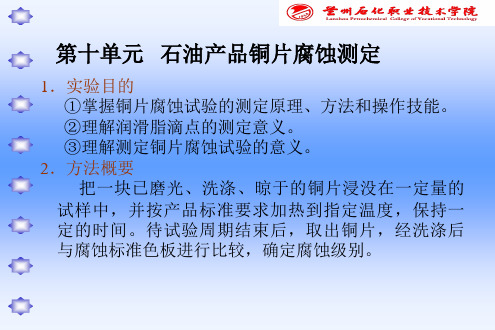
检查褪色的另一种方法是:当购进新色板 时,把一条20mm宽的不透明片(遮光片)放在这 块腐蚀标准色板带颜色部分的顶部。把不透明 片经常拿开,以检查暴露部分是否有褪色的迹 象。如果发现有任何褪色,则应该更换这块腐 蚀标准色板。
如果塑料板表面显示出有过多的划痕,则也 应该更换这块腐蚀标准色板。
表10-1 腐蚀标准色板的分级
最后磨光:从洗涤溶剂中取出铜片,用无灰滤纸保护手指 夹持铜片。取一些105μm(150目)的碳化硅或氧化铝(刚玉) 砂粒放在玻璃板上,用1滴洗涤溶剂湿润,并用一块脱脂棉, 蘸取砂粒。用不锈钢镊子夹持铜片,千万不能接触手指。先摩 擦铜片各端边,然后将铜片夹在夹钳上,用沾在脱脂棉上的碳 化硅或氧化铝(刚玉)砂粒磨光主要表面,要沿铜片的长轴方 向磨。再用一块干净的脱脂棉使劲地摩擦铜片,以除去所有金 属屑,直到新脱脂棉不留污斑为止。铜片擦净后,立即浸入已 准备好的试样中。
试验弹能浸没在浴液中。
磨片夹钳或夹具:磨片时牢固地夹住铜片而不损
坏边缘,并使铜片表面高出夹具表面;试管:长
150mm 、 外 径 25mm 、 壁 厚 1~2mm , 在 试 管 30mL
处刻一环线;观察试管:扁平形,在试验结束时,
供检验用或在储存期间供盛放腐蚀的铜片用;温度
计:全浸型、最小分度1℃或小于1℃,用于指示试
验温度,所测温度点的水银线伸出浴介质表面应不 图10-1 铜片腐蚀试验弹
大于25mm。
1-提环;2-弹盖;3-弹体
(2)试剂与材料 洗涤溶剂:分析纯90~120℃的石油醚或溶剂油;
铜片:纯度大于99.9%的电解铜,宽为12.5mm、厚 为1.5~3.0mm、长为75mm,铜片可以重复使用,但
当铜片表面出现有不能磨去的坑点或深道痕迹,或
石油产品铜片腐蚀性测试仪实验方法

石油产品铜片腐蚀性测试仪实验方法铜片腐蚀设备用于测定柴油、汽油、润滑油或其他石油产品对铜的腐蚀性程度(本方法涉及到易燃材料,操作时要注意安全)。
注意:本方法涉及到易燃材料,操作前要注意试样的燃点、闪点,操作时要注意安全铜片腐蚀设备主要部件。
一、水浴:能够维持在试验所需要的温度40、50、100±1℃、LED 显示温度,按键式控制。
用于确认输入值用于设定温度时改变数值的位数二、试验弹:按照ASTM D130 标准制造,用于部分油品测试(如:航空汽油等),内有橡胶垫圈,保持好的密封性。
三、试验试管:按照ASTM D130 标准制造,用于部分易挥发油品测试(如润滑油等)。
四、磨片夹具:磨片时可以牢固的夹住铜片,且不损坏边缘。
五、观察试管及试管固定夹:试验结束时,可以更方便的观察铜片的腐蚀状况。
六、砂纸及砂粒:240目、600目等颗粒粗细不同的磨光砂纸。
七、铜片:纯度大于99.9%的电解铜。
八、腐蚀标准色板:按照ASTM D130标准制造的标准色板,磨光后的铜片在油品中腐蚀后的可参照标准色板的腐蚀等级来判定油品的腐蚀性,铜片腐蚀标准色板要避光保存。
九、观察试管:扁平的观察试管更易观察变色或腐蚀迹象,除铜片腐蚀设备的部件外,还需准备滤纸、脱脂棉、试样、洗涤溶剂(在50℃,试验3小时不使铜片变色的任何易挥发、无硫烃类溶剂均可,如异辛烷、石油醚等)。
铜片的准备:1、用夹具纵向夹紧铜片,先用比较粗的砂纸(目数越低砂纸越粗)把铜片的瑕疵去掉,可来回调换夹具上铜片的方向,使铜片的六个面上所有部位上的瑕疵和以前打磨的痕迹都去掉,打磨完后可以用定量的滤纸擦去铜片上的金属屑,此时可以把铜片放入洗涤溶剂中清洗后擦干再进行最后磨光,也可以直接进行最后磨光,打磨的铜片均要拿镊子或滤纸来拿,不可以用手触摸。
2、用目数较高的砂纸打磨铜片或用蘸了砂粒的脱脂棉打磨铜的表面,磨时尽量沿铜片的长轴方向打磨。
3、在铜片打磨光亮后用脱脂棉擦去金属屑,铜片擦干净后放入准备好的试样中。
铜片腐蚀 标准

铜片腐蚀标准
摘要:
一、铜片腐蚀的概念与意义
二、铜片腐蚀的标准与方法
三、铜片腐蚀的测定设备
四、铜片腐蚀的判断与等级
五、铜片腐蚀的应用领域
正文:
一、铜片腐蚀的概念与意义
铜片腐蚀是指在特定环境条件下,铜片与腐蚀介质发生化学反应,导致铜片表面出现损害、颜色变化等现象。
铜片腐蚀的检测对于评估金属材料的耐蚀性、选材以及防腐措施的制定具有重要意义。
二、铜片腐蚀的标准与方法
铜片腐蚀的标准主要依据中华人民共和国石油化工行业标准SH/T 0232《液化石油气铜片腐蚀试验法》进行。
方法包括:恒温浴法、电化学法、重量法等。
三、铜片腐蚀的测定设备
铜片腐蚀测定仪是按照相关标准设计的设备,用于检测石油产品等对铜片的腐蚀程度。
主要性能特点包括:不锈钢浴槽,数显控温,温控表控制温度,四孔,可悬挂四弹或12 支试管,带计时器,计时结束自动报警等。
四、铜片腐蚀的判断与等级
铜片腐蚀的判断主要依据标准色板进行,通过比较腐蚀后的铜片表面颜色
与标准色板的差异,判断腐蚀等级。
常见的铜片腐蚀等级包括:1a、1b、2a、2b、2c 等。
腐蚀测试方法和标准

腐蚀测试方法和标准盐雾腐蚀测试用于评估金属、合金、涂料和塑料的耐腐蚀性。
它可用于评估材料在大气和海洋环境中的性能。
该测试可用于评估新材料或比较不同的材料。
腐蚀测试预期在腐蚀性液体、固体或气体中起作用的焊件可能会经过适当的试验室型腐蚀测试,这些测试供应了有关焊件在实际使用条件下表现的部分但令人充足的信息。
腐蚀测试仅在少数规范和规范中指定,由于大多数合金和焊接材料都是依据以前的阅历为特定应用选择的。
在焊接领域,对不锈钢和镍合金的焊接接头进行腐蚀测试,以评估它们在使用中的耐腐蚀环境。
腐蚀测试有多种形式,它们都包含在相对较薄的材料中制作焊接试样,并将其浸入相关规范或规范规定的确定温度和确定时间长度的试剂中。
其中最相关的是那些设计用于测试抗点蚀或晶间腐蚀性能的产品。
在焊接技术中,微晶间腐蚀交替称为敏化、碳化物沉淀和焊缝衰减。
ASTMG48“使用氯化铁溶液的点蚀和不锈钢缝隙耐腐蚀性及相关合金的标准测试方法”中描述了点蚀的合适测试。
用于腐蚀测试的ASTM评估测试用于检测晶间腐蚀的各种ASTM评估测试总结如下:1.A262PracticeA这是草酸蚀刻测试。
该测试包含在室温下用灯/cm在10重量百分比(wt%)草酸溶液中电解蚀刻抛光样品21.5分钟在该测试中,碳化铬或氮化物优先溶解,微观结构给出了铬耗尽的概念,这是导致晶间侵蚀的原因。
假如不存在碳化铬,则由于不同取向晶粒的蚀刻速率不同,在晶界处会产生台阶。
该测试可用于筛选合金以进行其他测试。
2.A262PracticeB这是应用于奥氏体不锈钢的硫酸铁测试。
在该测试中,将表面积为520cm2的样品暴露在装有Allihn冷凝器的锥形瓶中的沸腾的600ml溶液中120小时,该溶液为50wt%H2SO4+2.5wt%Fe(SO4)。
在暴露前后称量样品,并依据重量损失计算腐蚀速率。
它可以检测铬镍钼不锈钢(316,316L,317,317L)中与Σ相相关的敏感性,这是导致紧要在某些特定硝酸环境中快速晶间侵蚀的原因。
铜片腐蚀实验报告

铜片腐蚀实验报告铜片腐蚀实验报告引言:腐蚀是一种常见的物质变化现象,它在我们的日常生活中随处可见。
而铜片腐蚀实验则是一种常用的实验方法,用来研究铜在不同环境条件下的腐蚀特性。
本文将通过对铜片腐蚀实验的详细描述和分析,探讨腐蚀的原理和影响因素。
实验方法:本次实验使用的是普通铜片,将其分别放置在三个不同溶液中进行腐蚀实验。
第一个溶液是酸性溶液,由稀硫酸和水组成;第二个溶液是碱性溶液,由氢氧化钠和水组成;第三个溶液是中性溶液,由纯净水组成。
每个溶液中的铜片都放置在同样的条件下,如温度、湿度等。
实验结果:经过一段时间的观察,我们发现铜片在不同溶液中的腐蚀情况有所不同。
在酸性溶液中,铜片表面出现了明显的腐蚀痕迹,呈现出深棕色;在碱性溶液中,铜片表面也有一定的腐蚀现象,但相对较轻,呈现出浅棕色;而在中性溶液中,铜片表面几乎没有腐蚀迹象。
讨论:根据实验结果,我们可以得出结论:铜片在不同溶液中的腐蚀程度与溶液的酸碱性质有关。
酸性溶液中的氢离子(H+)能够与铜离子(Cu2+)发生反应,形成铜离子的溶液,从而导致铜片的腐蚀。
而碱性溶液中的氢氧根离子(OH-)能够与铜离子反应生成铜氢氧化物,起到一定的保护作用,减缓了铜片的腐蚀速度。
中性溶液中,由于溶液中没有足够的氢离子或氢氧根离子,所以铜片几乎不会发生腐蚀。
除了溶液的酸碱性质外,实验中还有其他因素可能会对铜片的腐蚀产生影响。
例如温度、湿度、氧气浓度等。
温度越高,腐蚀反应的速率越快,因为反应速率与温度呈正相关关系。
湿度越大,铜片表面的水分越多,也有利于腐蚀的发生。
氧气浓度也是一个重要因素,铜在氧气的存在下更容易被氧化,从而导致腐蚀。
结论:通过对铜片腐蚀实验的观察和分析,我们得出了以下结论:铜片的腐蚀程度与溶液的酸碱性质密切相关,酸性溶液中腐蚀最严重,碱性溶液中腐蚀较轻,而中性溶液中几乎没有腐蚀。
此外,温度、湿度和氧气浓度等因素也会对铜片的腐蚀产生影响。
腐蚀是一种普遍存在的现象,对于保护金属材料的安全和延长其使用寿命至关重要。
astm 铜腐蚀率

astm 铜腐蚀率
ASTM(美国材料与试验协会)通常不提供特定的铜腐蚀率标准,但ASTM会发布一系列涉及金属和合金腐蚀测试的标准,这些标准可以用于评估不同材料的腐蚀性能。
铜腐蚀率通常用于测试液体或环境对金属的腐蚀程度。
一种常用的铜腐蚀率测试是ASTM G31标准,标题为"Standard Practice for Laboratory Immersion Corrosion Testing of Metals",通常用于评估金属在不同液体环境中的腐蚀性能。
ASTM G31标准提供了测试程序,可用于测量金属在特定液体中的腐蚀速率。
测试中通常会使用铜试片,将其与待测试材料暴露在一定的液体环境中,并测量一段时间后铜试片的腐蚀程度,以评估环境的腐蚀性。
另一个与铜腐蚀相关的ASTM标准是ASTM G1,标题为"Standard Practice for Preparing, Cleaning, and Evaluating Corrosion Test Specimens"。
该标准涵盖了制备和清洁腐蚀试样的程序,其中包括使用铜试片作为评估腐蚀性能的一部分。
请注意,ASTM标准通常需要购买或获取,因此如果需要详细的测试程序和规格,建议查阅相关ASTM标准文件或咨询ASTM的官方网站。
对于特定应用或要测试的具体情况,可能需要根据ASTM标准来设计和执行腐蚀测试。
铜片腐蚀 标准 -回复
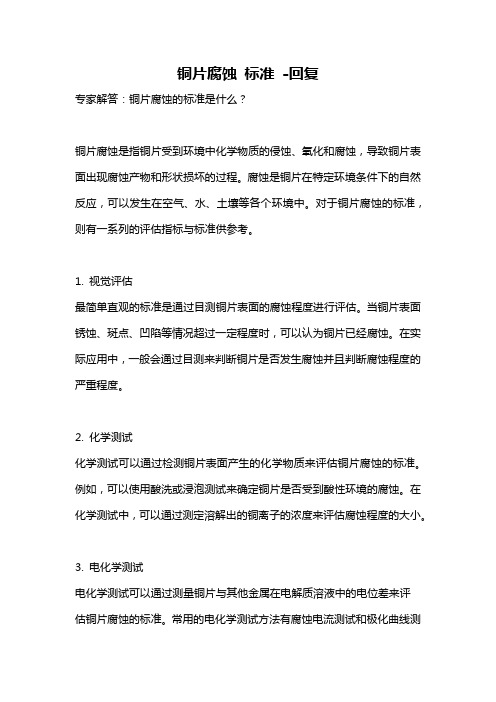
铜片腐蚀标准-回复专家解答:铜片腐蚀的标准是什么?铜片腐蚀是指铜片受到环境中化学物质的侵蚀、氧化和腐蚀,导致铜片表面出现腐蚀产物和形状损坏的过程。
腐蚀是铜片在特定环境条件下的自然反应,可以发生在空气、水、土壤等各个环境中。
对于铜片腐蚀的标准,则有一系列的评估指标与标准供参考。
1. 视觉评估最简单直观的标准是通过目测铜片表面的腐蚀程度进行评估。
当铜片表面锈蚀、斑点、凹陷等情况超过一定程度时,可以认为铜片已经腐蚀。
在实际应用中,一般会通过目测来判断铜片是否发生腐蚀并且判断腐蚀程度的严重程度。
2. 化学测试化学测试可以通过检测铜片表面产生的化学物质来评估铜片腐蚀的标准。
例如,可以使用酸洗或浸泡测试来确定铜片是否受到酸性环境的腐蚀。
在化学测试中,可以通过测定溶解出的铜离子的浓度来评估腐蚀程度的大小。
3. 电化学测试电化学测试可以通过测量铜片与其他金属在电解质溶液中的电位差来评估铜片腐蚀的标准。
常用的电化学测试方法有腐蚀电流测试和极化曲线测试。
这些测试可以测定铜片腐蚀速率、腐蚀电流密度等参数,从而评估铜片的腐蚀程度。
4. 重量损失评估重量损失评估是通过测量铜片腐蚀前后的重量差来评估腐蚀程度的标准。
将铜片暴露在特定环境中一段时间后,取下铜片进行称重,然后与未暴露的铜片进行对比,计算出重量差,从而得出铜片的腐蚀量。
5. 表面形貌评估表面形貌评估是通过显微镜等设备观察铜片表面的形貌变化来评估腐蚀的标准。
通过观察铜片的表面形貌,可以判断是否存在锈蚀、划痕、凹坑等腐蚀现象,从而评估腐蚀程度。
综上所述,铜片腐蚀的标准可以通过视觉评估、化学测试、电化学测试、重量损失评估和表面形貌评估等多种指标来确定。
通过这些评估标准可以对铜片的腐蚀程度进行准确评估,进一步制定相应的防腐措施。
石油产品铜片腐蚀测定法

中国石油内蒙古销售公司
四、实验——准备
Ø 用定量滤纸擦去铜片上的金属屑后, 把铜片浸没在 洗涤溶剂中。
GB/T 5096-1985
中国石油内蒙古销售公司
四、实验——准备
n 从洗涤溶剂中取出铜片,用1滴洗涤溶剂湿润,并 用一块脱脂棉擦铜片,以除去所有金属屑。
GB/T 5096-1985
中国石油内蒙古销过 短均影响操作结果。
GB/T 5096-1985
中国石油内蒙古销售公司
四、实验——步骤
n 用不锈钢镊子立即将铜片从试管中取出,浸入放有 洗涤溶剂的150mL高型烧杯中,洗去试样。
GB/T 5096-1985
中国石油内蒙古销售公司
四、实验——步骤
n 立即取出铜片,用定量滤纸吸干铜片上的洗涤溶 剂。
八、注意事项
n 试验所用洗涤剂必须经铜片试验合格才能使用。 n 试验所用铜片的纯度和规格必须符合标准规定。 n 处理铜片表面时,要防止铜片与手接触,以免手 上汗渍对结果造成影响。 n 腐蚀标准色板应避光存放,否则影响结果判断。 n 试样应避光储存,收到试样,尽快进行腐蚀试 验。 n 避免铜片与水接触影响试验结果。 n 防止铜片与空气接触,磨光的铜片要马上浸入已 准备好的试样;放入时小心滑入,以避免打碎试管。
四、实验——准备
铜片腐蚀仪器设备检查 1、检查仪器电源、机壳是否接地良好。 2、检查水浴是否达到试验操作要求水位。 3、检查浴内温度传感器是否正常。
GB/T 5096-1985
中国石油内蒙古销售公司
四、实验——步骤
n 将试验仪器放置平稳,接通电源,使水浴温度维持 在50±1℃。
GB/T 5096-1985
中国石油内蒙古销售公司
三、仪器、材料、试剂准备——试剂与材料
- 1、下载文档前请自行甄别文档内容的完整性,平台不提供额外的编辑、内容补充、找答案等附加服务。
- 2、"仅部分预览"的文档,不可在线预览部分如存在完整性等问题,可反馈申请退款(可完整预览的文档不适用该条件!)。
- 3、如文档侵犯您的权益,请联系客服反馈,我们会尽快为您处理(人工客服工作时间:9:00-18:30)。
Designation:D130–94(Reapproved2000)e1(21262°F),or both,and having suitable supports to hold the test tubes in a vertical position and immersed to a depth of about 100mm (4in.).Either water,oil,or aluminum block baths are suitable.5.2Copper Strip Corrosion Test Bomb ,constructed of stainless steel according to the dimensions as given in Fig.1,and capable of withstanding a test pressure of 100psi (689kPa).Alternative designs for the bomb cap and synthetic rubber gasket may be used provided that the internal dimen-sions of the bomb are the same as those shown in Fig.1.Provide a 25by 150-mm test tube as a liner for holding the sample.5.2.1Provide liquid baths capable of being maintained at 4061°C (10462°F)or 10061°C (21262°F),or both,and having suitable supports to hold the test bomb in a vertical position.The bath must be deep enough so that the entire bomb will be submerged during the test.As the bath medium,use water or any other liquid which can be satisfactorily controlled at the specified test temperature.5.3Thermometers ,total immersion,for indicating the re-quired test temperature,with smallest graduations of 1°C (2°F)or less.No more than 25mm (1in.)of the mercury thread should extend above the surface of the bath at the test temperature.The ASTM 12C (12F)or IP 64C (64F)thermom-eter is suitable.5.4Polishing Vise ,for holding the copper strip firmly without marring the edges while polishing.Any convenient type of holder (see Appendix)may be used provided that the strip is held tightly and that the surface of the strip being polished is supported above the surface of the holder.5.5Viewing Test Tubes ,flat glass test tubes,are convenient for protecting corroded strip for close inspection or storage (see Appendix).6.Materials6.1Wash Solvent —Any volatile,sulfur-free hydrocarbon solvent may be used provided that it shows no tarnish at allwhen tested at 50°C (122°F).Knock test grade iso octane is a suitable solvent and should be used in case of dispute.(Warning —Extremely flammable,see A2.1.)6.2Polishing Materials —Silicon carbide grit paper of vary-ing degrees of fineness including 65-µm (240-grit)paper or cloth;also a supply of 105-µm (150-mesh)silicon carbide grain and pharmaceutical grade absorbent cotton (cotton wool).6.3Copper Strips :6.3.1Specification —Use strips 12.5mm (1⁄2in.)wide,1.5to 3.0mm (1⁄16to 1⁄8in.)thick,cut 75mm (3in.)long from smooth-surfaced,hard-temper,cold-finished copper of 99.9+%purity;electrical bus bar stock is generally suitable (see Appendix).The strips may be used repeatedly but should be discarded when the surfaces become deformed on handling.6.3.2Surface Preparation —Remove all surface blemishes from all six sides of the strip with silicon carbide paper of such degrees of fineness as are needed to accomplish the desired results efficiently.Finish with 65-µm (240-grit)silicon carbide paper or cloth,removing all marks that may have been made by other grades of paper used previously.Immerse the strip in wash solvent from which it can be withdrawn immediately for final preparation (polishing)or in which it can be stored for future use.6.3.2.1As a practical manual procedure for surface prepa-ration,place a sheet of the paper on a flat surface,moisten it with kerosine or wash solvent,and rub the strip against the paper with a rotary motion,protecting the strip from contact with the fingers with an ashless filter paper.Alternatively,the surface of the strip can be prepared by use of motor-driven machines using appropriate grades of dry paper or cloth.6.3.3Final Preparation —Remove a strip from the wash solvent.Holding it in the fingers protected with ashless filter paper,polish first the ends and then the sides with the 105-µm (150-mesh)silicon carbide grains picked up from a clean glass plate with a pad of cotton (cotton wool)moistened with a drop of wash solvent.Wipe vigorously with fresh pads of cotton (cotton wool)and subsequently handle only with stainless steel forceps;do not touch with the fingers.Clamp in a vise and polish the main surfaces with silicon-carbide grains on absor-bent cotton.Do not polish in a circular motion.Rub in the direction of the long axis of the strip,carrying the stroke beyond the end of the strip before reversing the direction.Clean all metal dust from the strip by rubbing vigorously with clean pads of absorbent cotton until a fresh pad remains unsoiled.When the strip is clean,immediately immerse it in the prepared sample.6.3.3.1It is important to polish the whole surface of the strip uniformly to obtain a uniformly stained strip.If the edges show wear (surface elliptical)they will likely show more corrosion than the center.The use of a vise (see Appendix)will facilitate uniform polishing.6.3.3.2It is important to follow the order of preparation with the correctly sized silicon carbide material as described in 6.3.2and 6.3.3.The final preparation is with 105-µm silicon carbide grains.This is a larger grain size than the 65micron paper used in the surface preparation stage.The reason for this use of larger silicon carbide grains in the final preparation is to produce asperities (controlled roughness)on the surface oftheFIG.1Copper Strip Corrosion TestBombcopper which acts as sites for the initiation of corrosion reactions.7.Corrosion Standards7.1ASTM Copper Strip Corrosion Standards 4consist of reproductions in color of typical test strips representing in-creasing degrees of tarnish and corrosion,the reproductions being encased in plastic in the form of a plaque.7.1.1Keep the plastic-encased printed ASTM Copper Strip Corrosion Standards protected from light to avoid the possi-bility of fading.Inspect for fading by comparing two different plaques,one of which has been carefully protected from light (new).Observe both sets in diffused daylight (or equivalent)first from a point directly above and then from an angle of 45°.When any evidence of fading is observed,particularly at the left-hand end of the plaque,it is suggested that the one that is the more faded with respect to the other be discarded.7.1.1.1Alternatively,place a 20-mm (3⁄4-in.)opaque strip (masking tape)across the top of the colored portion of the plaque when initially purchased.At intervals remove the opaque strip and observe.When there is any evidence of fading of the exposed portion,it is suggested that the standards be replaced.7.1.1.2These plaques are full-color reproductions of typical strips.They have been printed on aluminum sheets by a 4-color process and are encased in plastic for protection.Directions for their use are given on the reverse side of each plaque.7.1.2If the surface of the plastic cover shows excessive scratching it is suggested that the plaque be replaced.8.Samples8.1It is particularly important that all types of fuel samples,which pass a low-tarnish strip classification,be collected in clean,dark glass bottles,plastic bottles,or other suitable containers that will not affect the corrosive properties of the fuel.Avoid the use of tin plate containers for collection of samples,since experience has shown that they may contribute to the corrosiveness of the sample.8.2Fill the containers as completely as possible and close them immediately after taking the sample.Take care during sampling to protect the samples from exposure to direct sunlight or even diffused daylight.Make the test as soon as possible after receipt in the laboratory and immediately after opening the container.8.3When suspended water (haze)is observed in the sample,dry by filtering a sufficient volume of sample through a medium rapid qualitative filter,into the prescribed clean,dry test tube.Carry out this operation in a darkened room or under a light-protected shield.8.3.1Contact of the copper strip with water before,during,or after the completion of the test run,will cause staining,making it difficult to evaluate the strips.9.Procedure9.1Those product classes,to which given procedural varia-tions are intended to be applied,are listed below.Some productclasses,being quite broad,may be tested by more than one set of conditions;in such cases the copper strip quality require-ment for a given product should be limited to a single set of conditions.The conditions of time and temperature given below are those most commonly used and are quoted in the ASTM specifications for these products where such specifica-tions exist.However,other conditions can also be used as and when required by specifications or by agreement between parties.9.1.1For aviation gasoline,and aviation turbine fuel —Place 30mL of sample,completely clear and free of any suspended or entrained water (see 8.3)into a chemically clean,dry 25by 150-mm test tube,and within 1min after completing the final preparation (polishing),slide the copper strip into the sample tube.Carefully slide the sample tube into the test bomb (Fig.1)and screw the lid on pletely immerse the bomb in a boiling water bath at 10061°C (21262°F).After 2h 65min in the bath,withdraw the bomb and immerse for a few minutes in tap water.Open the bomb,withdraw the test tube and examine the strip as described in 9.2.9.1.2For natural gasoline —Carry out the test exactly as described in 9.1.1but at 40°C (104°F)and for 3h 65min.9.1.3For diesel fuel,fuel oil,automotive gasoline —Place 30mL of sample,completely clear and free of any suspended or entrained water (see 8.3),into a chemically clean,dry 25by 150-mm test tube and,within 1min after completing the final preparation (polishing),slide the copper strip into the sample tube.Stopper with a vented cork and place in a bath maintained at 5061°C (12262°F)(see 5.1.1).Protect the contents of the test tube from strong light during the test.After 3h 65min in the bath,examine the strip as described in 9.2.For tests on fuel oil and diesel fuel,to specifications other than Specifications D 396and D 975,a temperature of 100°C (212°F)for 3h is often used as an alternative set of conditions.9.1.4For cleaners (Stoddard)solvent and kerosine —Carry out the test exactly as described in 9.1.3but at 10061°C (21262°F).9.1.5For lubricating oil —Tests can be carried out for varying times and at elevated temperatures other than 100°C (212°F).For the sake of uniformity,it is suggested that even increments of 50°F beginning with 250°F (or Celsius equiva-lents to the nearest whole degree)be used.9.2Strip Examination :9.2.1Empty the contents of the test tube into a 150-mL tall-form beaker,letting the strip slide in gently so as to avoid breaking the beaker.Immediately withdraw the strip with stainless steel forceps and immerse in wash solvent.Withdraw the strip at once,dry with quantitative filter paper (by blotting and not by wiping),and inspect for evidences of tarnishing or corrosion by comparison with the Copper Strip Corrosion Standards.Hold both the test strip and the standard strip plaque in such a manner that light reflected from them at an angle of approximately 45°will be observed.9.2.2In handling the test strip during the inspection and comparison,the danger of marking or staining can be avoided if it is inserted in a flat glass tube (see Appendix X1)which can be stoppered with absorbent cotton.4Conforming to Copper Development Assn.(CDA),United States of America No.110,or to British Standard (BS)1036:1952,which have properquality.10.Interpretation10.1Interpret the corrosiveness of the sample accordingly as the appearance of the test strip agrees with one of the strips of the ASTM Copper Strip Corrosion Standards.10.1.1When a strip is in the obvious transition state between that indicated by any two adjacent standard strips,judge the sample by the more tarnished Standard Strip.Should a strip appear to have a darker orange color than Standard Strip 1b ,consider the observed strip as still belonging in Classifica-tion 1;however,if any evidence of red color is observed,the observed strip belongs in Classification 2.10.1.2A claret red strip in Classification 2can be mistaken for a magenta overcast on brassy strip in Classification 3if the brassy underlay of the latter is completely masked by a magenta overtone.To distinguish,immerse the strip in wash solvent;the former will appear as a dark orange strip while the latter will not change.10.1.3To distinguish multicolored strips in Classifications 2and 3,place a test strip in a 20by 150-mm test tube and bring to a temperature of 315to 370°C (600to 700°F)in 4to 6min with the tube lying on a hot plate.Adjust to temperature by observing a high distillation thermometer inserted into a second test tube.If the strip belongs in Classification 2,it willassume the color of a silver and then a gold strip,if in Classification 3it will take on the appearance of a transparent black,etc.,as described in Classification 4.10.1.4Repeat the test if blemishes due to finger prints are observed,or due to spots from any particles of water droplets that may have touched the test strip during the digestion period.10.1.5Repeat the test also if the sharp edges along the flat faces of the strip appear to be in a classification higher than the greater portion of the strip;in this case it is likely that the edges were burnished during preparation (polishing).11.Report11.1Report the corrosiveness in accordance with one of the classifications listed in Table 1.State the duration of the test and the test temperature.12.Precision and Bias12.1In the case of pass/fail data no generally accepted method for determining precision or bias is currently available.13.Keywords13.1automotive gasoline;aviation gasoline;aviation tur-bine fuel;copper corrosion;copper strip finish;corrosiveness to copper;natural gasolineTABLE 1Copper Strip ClassificationsClassification Designation Description AFreshly polished strip ...B1slight tarnisha.Light orange,almost the same as freshly polished stripb.Dark orange 2moderate tarnish a.Claret red ... vender... c.Multicolored with lavender blue or silver,or both,overlaid on claret red ... d.Silvery...e.Brassy or gold3dark tarnish a.Magenta overcast on brassy strip... b.Multicolored with red and green showing (peacock),but no gray4corrosion a.Transparent black,dark gray or brown with peacock green barely showing ... b.Graphite or lusterless black ...c.Glossy or jet blackAThe ASTM Copper Strip Corrosion Standard is a colored reproduction of strips characteristic of these descriptions.BThe freshly polished strip is included in the series only as an indication of the appearance of a properly polished strip before a test run;it is not possible to duplicate this appearance after a test even with a completely noncorrosivesample.ANNEXES(Mandatory Information)A1.COPPER QUALITYA1.1Copper QualityA1.1.1Hard-temper,cold-finished type-(ETP)electrolytic tough pitch copper.4A2.PRECAUTIONARY STATEMENTA2.1IsooctaneHarmful if inhaled.Vapors may cause flash fire.Keep away from heat,sparks,and open flame.Keep container closed.Use with adequate ventilation.Avoid build-up of vapors and eliminate all sources of ignition,especially nonexplosion proof electrical apparatus and heaters.Avoid prolonged breathing of vapor or spray mist.Avoid prolonged or repeated skin contact.A2.2Aviation Turbine Fuel (Jet A or A-1,seeSpecification D 1655)Keep away from heat,sparks,and open flames.Keep container closed.Use with adequate ventilation.Avoid breathing vapor or spray mist.Avoid prolonged or repeated contact with skin.A2.3Gasoline (Containing Lead)Keep away from heat,sparks,and open flame.Keep container closed.Use with adequate ventilation.Avoid build-up of vapors and eliminate all sources of ignition,especially nonexplosion-proof electrical apparatus and heaters.Avoid prolonged breathing of vapor or spray mist.Avoid prolonged or repeated skin contact.A2.4Gasoline (White or Unleaded)Keep away from heat,sparks,and open flame.Keep container closed.Use with adequate ventilation.Avoid build-up of vapors and eliminate all sources of ignition,especially nonexplosion-proof electrical apparatus and heaters.Avoid prolonged breathing of vapor or spray mist.Avoid prolonged or repeated skin contact.A2.5KerosineKeep away from heat,sparks,and open flame.Keep container closed.Use with adequate ventilation.Avoid breathing vapor or spray mist.Avoid prolonged or repeated contact with skin.A2.6Stoddard SolventKeep away from heat,sparks,and open flame.Keep container closed.Use with adequate ventilation.Avoid breathing vapor or spray mist.Avoid prolonged or repeated contact with skin.APPENDIX(Nonmandatory Information)X1.OPTIONAL USEFUL EQUIPMENTX1.1Viewing TubeX1.1.1A useful flat glass test tube for holding tarnished copper strips for inspection or for storage for later inspection is illustrated and dimensioned in Fig.X1.1.X1.2Strip ViseX1.2.1A useful and convenient vise for holding up to four copper strips during final polishing is illustrated and dimen-sioned in Fig.X1.2.FIG.X1.1Flat Glass Test TubeFIG.X1.2Multistrip ViseASTM International takes no position respecting the validity of any patent rights asserted in connection with any item mentioned in this ers of this standard are expressly advised that determination of the validity of any such patent rights,and the risk of infringement of such rights,are entirely their own responsibility.This standard is subject to revision at any time by the responsible technical committee and must be reviewed everyfive years and if not revised,either reapproved or withdrawn.Your comments are invited either for revision of this standard or for additional standards and should be addressed to ASTM International Headquarters.Your comments will receive careful consideration at a meeting of the responsible technical committee,which you may attend.If you feel that your comments have not received a fair hearing you should make your views known to the ASTM Committee on Standards,at the address shown below.This standard is copyrighted by ASTM International,100Barr Harbor Drive,PO Box C700,West Conshohocken,PA19428-2959, United States.Individual reprints(single or multiple copies)of this standard may be obtained by contacting ASTM at the above address or at610-832-9585(phone),610-832-9555(fax),or service@(e-mail);or through the ASTM website ().。
